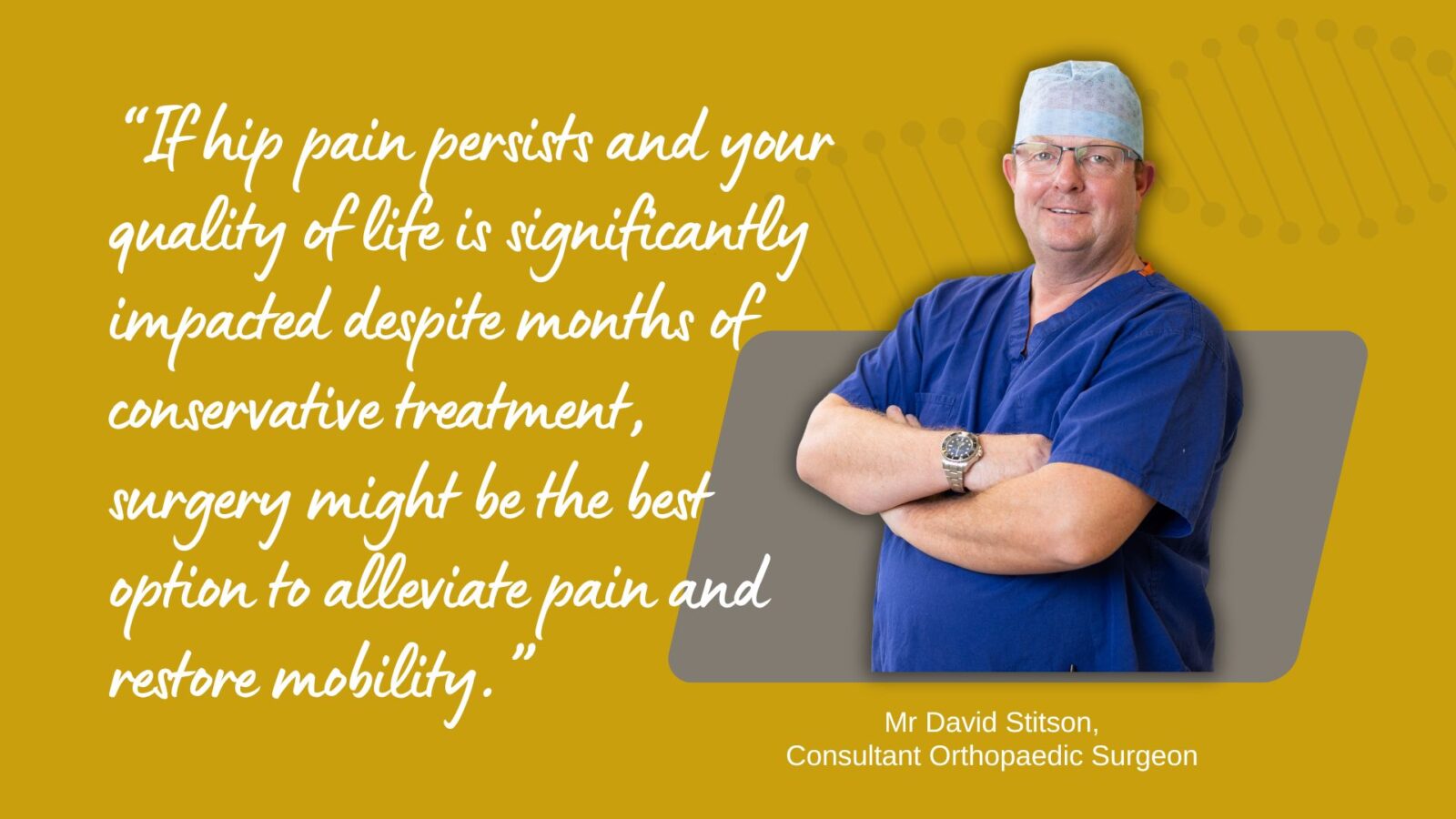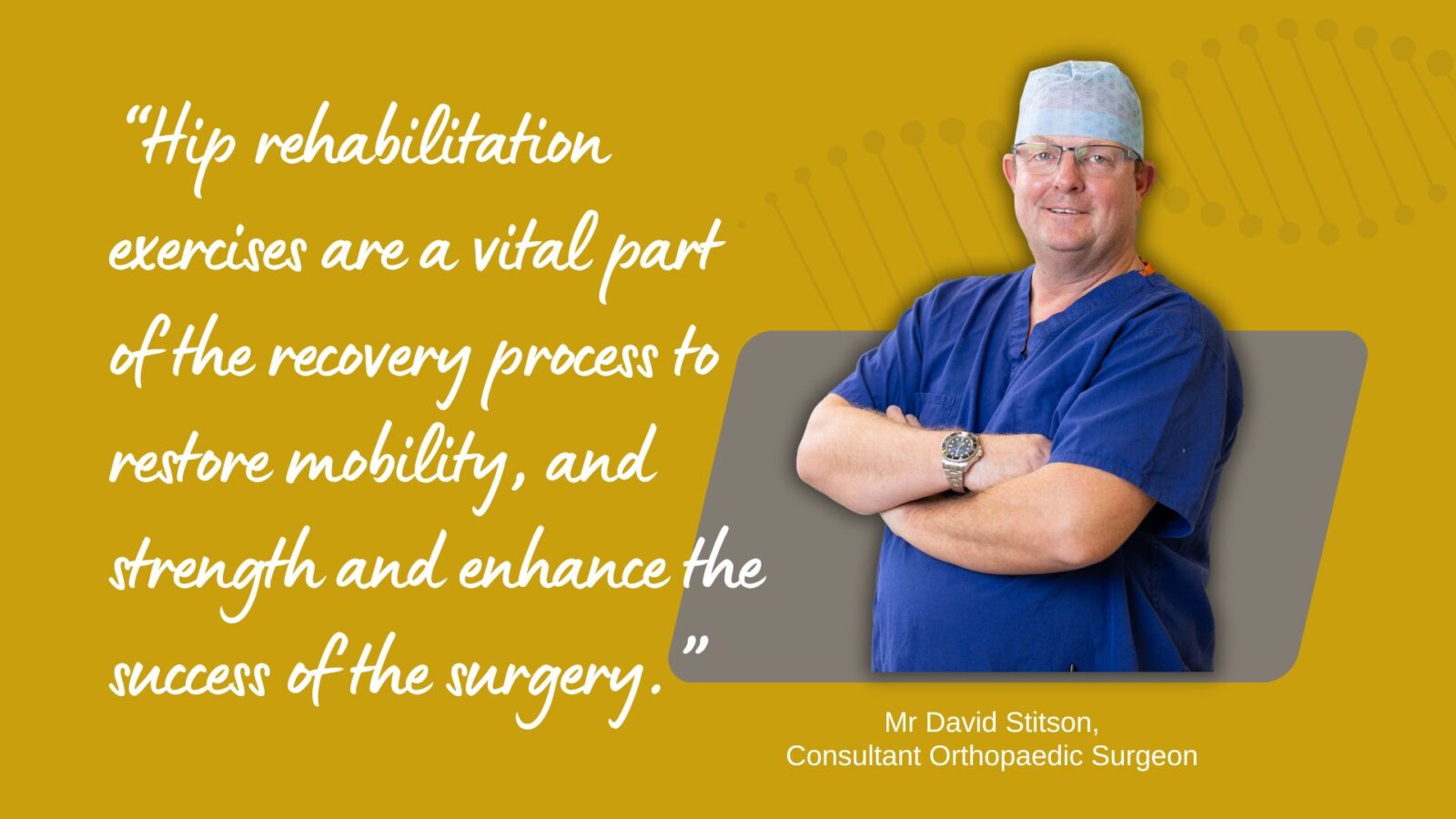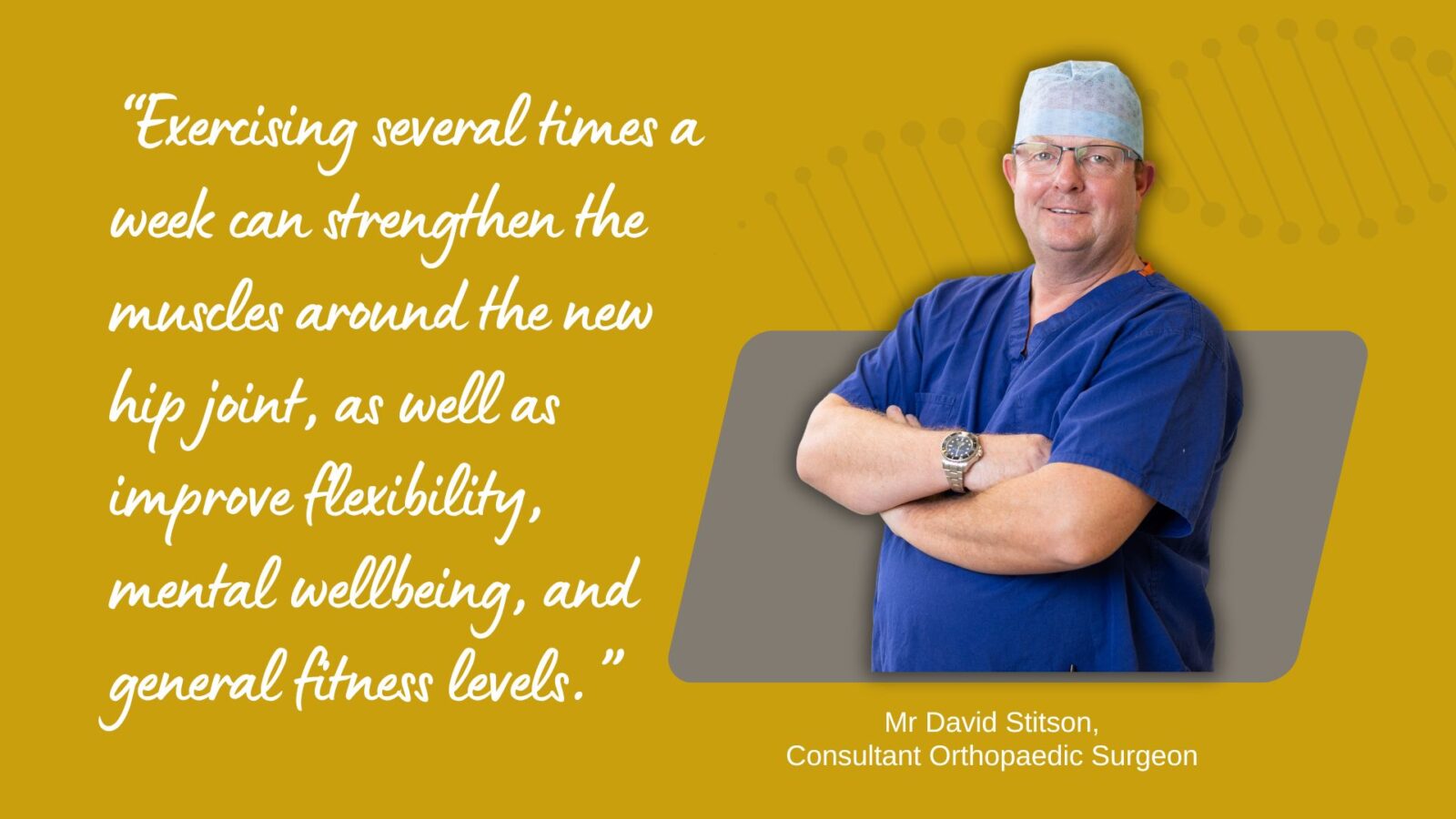Hip replacement surgery is a significant procedure aimed at improving mobility and relieving pain in individuals suffering from severe degenerative change in the hip joint.
Understanding the Hip Replacement Recovery Timeline is crucial for setting realistic post-surgery expectations and for a successful healing process. The recovery journey involves several stages, each with its own set of milestones and challenges. By familiarising yourself with these stages, you can better prepare for the road to recovery and manage any difficulties that may arise during your hip surgery recovery.
STAGE 1 – Immediate Post-Surgery Phase
The immediate post-surgery phase is a crucial period in the hip replacement recovery timeline. It is characterised by significant rest and careful observation by medical professionals to ensure the absence of complications and to set a solid foundation for healing.
Hospital Stay and Initial Recovery
Following hip replacement surgery, patients typically remain in the hospital for a day or two. During this time, medical staff closely monitor vital signs, incision sites and overall recovery progression. The hospital stay is an opportunity for patients to start the transition from surgery to recovery. Nurses and doctors will assess the surgical site for any signs of infection and evaluate pain levels, adjusting medications as necessary.
Physiotherapists will visit to guide patients through simple leg and ankle movements. These exercises prevent blood clots and promote circulation. Initial walking will begin during this phase with the aid of a walker or crutches. The goal during this period is to gradually increase the range of movement while ensuring the wound remains unharmed.
Pain Management and Medication
Post-surgery, managing pain effectively is paramount for both comfort and recovery. Patients will receive pain relief medications, which may include opioids for the short term, alongside non-steroidal anti-inflammatory drugs (NSAIDs). While opioids can be effective, it is important for patients to use them as prescribed to avoid dependency. As recovery progresses, healthcare providers will typically aim to reduce pain medication in favour of milder options.
Medications to prevent blood clots, known as blood thinners, are often prescribed. These are vital in your healing process, ensuring that circulation remains optimal and aiding in the prevention of deep vein thrombosis (DVT) and pulmonary embolus (PE).
Early Mobility and Exercise
Early mobility is critical in the immediate post-surgery phase. Physiotherapists will encourage patients to begin moving as soon as it Is safely possible. Structured exercises focus on strengthening the hip joint and supporting musculature. Initial mobilisations may feel challenging but they are essential in preventing stiffness and maintaining circulation.
Typically, simple activities include gentle flexing of the ankles and toes, along with assisted leg movements. These exercises, alongside monitored walking, support the healing process and prepare the body for increased activity in the weeks ahead.
STAGE 2 – Weeks 1-6: The Early Recovery Stage
This stage of recovery involves transitioning from hospital discharge to home. During this period, patients are encouraged to steadily increase their levels of activity, while still treating their bodies with care.
Managing Swelling and Bruising
Swelling and bruising around the incision area are common and typically subside within a few weeks. To manage these symptoms, elevating the leg and applying cold compresses can be effective. However, care should be taken not to place ice directly on the skin. Instead, wrap a cold pack in a towel and apply for 15-20 minutes several times a day. These measures, combined with mobility and therapeutic exercises, contribute to a smoother recovery experience.
Importance of Physiotherapy
Physiotherapy is a pivotal component of the early recovery stage. A structured physiotherapy programme not only aids in strengthening the hip joint but also helps restore flexibility and balance. Physiotherapists tailor hip exercises to meet individual needs and capabilities, often starting with simple movements such as seated knee and thigh extensions.
Regular physiotherapy sessions or structured home exercise for your new hip will focus on gradually increasing the difficulty and intensity of the exercises, ensuring the new hip joint’s functionality is restored correctly. Compliance with these exercises is key to achieving optimal recovery outcomes and can significantly affect overall satisfaction after surgery.
Tips for Safe Home Mobility
As patients adapt to life outside the hospital, safe home mobility becomes a priority. Here are several tips for navigating this phase safely:
– Remove any trip hazards, such as loose rugs and clutter, from walkways at home.
– Use assistive devices like walkers, crutches or sticks as instructed by healthcare providers.
– Ensure chairs and beds are at an appropriate height to avoid excessive bending when sitting or standing.
– Install grab bars / rails on exterior doors and in bathrooms for support.
Following these precautions and continuing with recommended exercises, patients can enhance their hip replacement recovery timeline and gradually regain independence in their daily activities. By adhering to healthcare advice, monitoring recovery progress, and maintaining a positive outlook, a smooth transition through the hip replacement recovery timeline is achievable.
STAGE 3 – Weeks 6-12: Progressing with Rehabilitation
As you move into weeks 6 to 12 following your hip replacement, the focus shifts to progressing through rehabilitation. This period of the hip replacement recovery timeline is crucial for regaining strength, improving mobility and enhancing the overall function of your new hip joint. During this time, you will notice significant improvement in your ability to perform daily activities. Consistent effort and adherence to your prescribed rehabilitation plan play a pivotal role in achieving a successful recovery.
Building Strength through Exercises
Exercise is a fundamental component of recovery during weeks 4 to 12. Under the guidance of your physiotherapist, you will engage in a structured exercise programme designed to bolster strength and increase flexibility around the hip joint. This often includes:
– Strengthening Exercises: Target muscles around the hip and thigh, such as quadriceps, hamstrings and glutes, to support the new joint.
– Balance and Stability Training: Exercises aimed at improving balance help reduce the risk of falls, safeguarding your hip.
– Low-Impact Aerobic Activities: Walking, swimming, and cycling on a stationary bike can enhance cardiovascular health without placing excessive strain on the hip.
It is vital to follow your physiotherapist’s guidelines, progressively increasing the intensity and duration of exercises as your endurance builds. Regular hip exercises not only assists in quicker recovery but also contributes to long-term joint health.
Monitoring Signs of Complications
Though most hip replacements proceed without significant issues, it remains important to be vigilant for any signs of complications. Monitoring your recovery involves keeping an eye out for the following:
– Excessive Swelling or Redness: While some swelling is normal, unusual levels of swelling or redness could indicate infection.
– Severe Pain: Persistent or worsening pain may suggest a problem that needs addressing.
– Signs of Deep Vein Thrombosis (DVT): Be alert for symptoms such as pain or swelling in the calf, which can indicate a blood clot.
Report any concerning symptoms to your healthcare provider promptly to ensure any complications are addressed in a timely manner.
Adjusting to Increased Activity Levels
As you make progress through rehabilitation, you may need to adjust to higher levels of activity. It is advisable to gradually reintroduce daily tasks and chores that you were accustomed to before surgery. This can include:
– Climbing Stairs: Slowly incorporate stair climbing into your routine as strength and stability improve.
– Resuming Household Chores: Activities such as light cleaning or gardening can be reintroduced, keeping strenuous tasks limited.
– Returning to Work or Social Activities: Depending on the demands of your job or social life, you may find it feasible to return to some of these activities.
It is crucial to listen to your body and avoid overexertion. Fatigue and soreness are common, and rest is an equally important aspect of the healing process.
Long-Term Recovery and Lifestyle Adjustments
Once you have navigated through the initial post-operative months, the journey towards full recovery continues. Long-term recovery involves making lifestyle adjustments that support the longevity of your hip replacement and ensure a high quality of life.
– Maintaining a Healthy Weight: Keeping a healthy weight reduces undue stress on the hip joint, enhancing its lifespan.
– Regular Exercise: Continuing with a regimen of low-impact exercises helps maintain hip strength and flexibility.
– Routine Check-Ups: Regular follow-ups with your orthopaedic surgeon are essential to ensure the hip replacement remains functional and to exclude any early issues.
Adopting habits that promote joint health is vital as part of your long-term recovery strategy. By making these adjustments, you can enjoy improved mobility and a more active lifestyle well into the future. Embracing these changes and following expert advice will help you derive the most benefit from your hip replacement surgery.
Hip Replacement Recovery Timeline FAQs
Q: How long does it take to recover from hip replacement surgery?
A: Complete recovery from hip replacement surgery can take between 6 to 12 months. However, many patients resume light activities in 3 to 6 weeks. Most will be free of walking aids by 6-weeks but some may need to use a walking stick for a little longer. Recovery timelines can vary significantly depending on individual health, the type of surgery performed and adherence to rehabilitation protocols.
Q: Can I return to normal activities after hip replacement?
A: Yes, you can return to most everyday activities; however, it requires patience and following your healthcare provider’s advice. Low-impact activities like walking or swimming are generally encouraged within a few months post-surgery. High-impact sports may need to be avoided or modified to prevent damage to the new joint.
Q: Are there any long-term restrictions after hip replacement?
A: While hip replacements are designed to last long, certain precautions should be observed to maintain joint health:
- Avoid high-impact sports
- Refrain from crossing your legs at the knee
- Keep regular follow-up appointments to monitor implant status
Q: What should I do if I experience pain during recovery?
A: Experiencing some discomfort is common during the healing process. If the pain becomes intense or persistent, consult your healthcare provider to rule out potential complications. They may suggest pain management strategies or adjustments to your rehabilitation plan.
About Hip Surgery
Total hip replacement surgery replaces the worn-out painful and stiff hip joint with a new prosthetic joint. This procedure is normally performed under spinal anaesthesia and is commonly followed by a night or two in the hospital. Day-case hip replacement surgery may be an appropriate option for you.

About Mr Stitson
David Stitson is a Plymouth-based Consultant Trauma and Orthopaedic Surgeon. Trained both in the UK and internationally, he has worked in medicine for more than 20 years for the NHS, for the Royal Air Force and in private practice. Mr Stitson operates privately at the Nuffield Health Hospital, Plymouth.

The Nuffield Plymouth CQC Rating
The Nuffield Hospital has a history that spans over half a century and has built a reputation for high standards of care, professionalism and expertise in delivering health services. They aim for continuous quality improvement in everything they do.
Active Quality and Governance programmes are in place at the Nuffield Hospital Plymouth. As part of this, the hospital is inspected by independent healthcare regulators to ensure it meets the fundamental standards of quality and safety as determined by the regulating body (CQC).
In the most recent inspection, Plymouth Nuffield Hospital was rated as ‘Good’ overall, however, the surgical element of the inspection was rated as ‘Outstanding’. The hospital was referred to as:
“Outstanding in effective and caring, and
Good in safe, responsive and well-led.”







